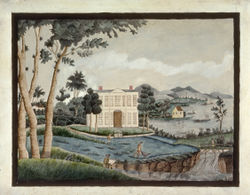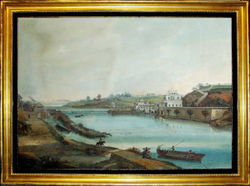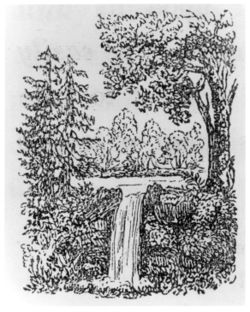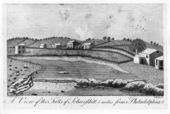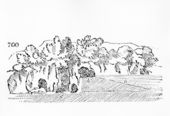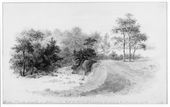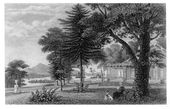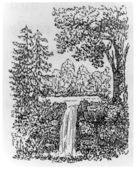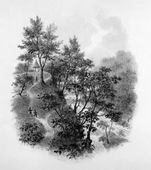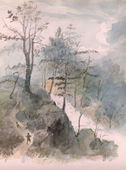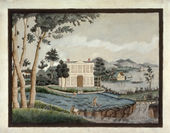Difference between revisions of "Cascade/Cataract/Waterfall"
V-Federici (talk | contribs) m |
|||
| (62 intermediate revisions by 10 users not shown) | |||
| Line 1: | Line 1: | ||
==History== | ==History== | ||
| − | Cascade, cataract, and waterfall were terms used interchangeably to designate a water feature, either natural or artificial, that was part of a designed landscape. These terms, which were synonymous, were in common usage and garden literature by the beginning of the | + | [[File: 1854.jpg|thumbnail|left|Fig. 1, Cornelius Tiebout, "[[View]] of the Falls of [[Schuylkill_River|Schuylkill]], five miles from Philadelphia," 1793.]] |
| + | [[File: 0358.jpg|thumbnail|right|Fig. 2, Anonymous, "[[Rustic_style|Rustic]] [[Seat]]," [[Montgomery Place]], in [[A. J. Downing]], ed., ''Horticulturist'' 2, no. 4 (October 1847): 157, fig. 26.]] | ||
| + | Cascade, cataract, and waterfall were terms used interchangeably to designate a water feature, either natural or artificial, that was part of a designed landscape. These terms, which were synonymous, were in common usage and garden literature by the beginning of the 18th century. Only [[Noah Webster|Noah Webster's]] dictionary (1828) made any distinction among them, stating that the cataract was a cascade on a large scale. The more frequent synonymous usage of the terms is found in [[Andrew Jackson Downing|A. J. Downing's]] essay on [[Montgomery Place]] (1847), where he entitled a section, “The cataract,” but then used the term “waterfall” in the text that followed. | ||
| + | [[File: 0849.jpg|thumbnail|left|Fig. 3, [[Alexander Jackson Davis]], ''View in Grounds at Blithewood, Seat of Robt. Donaldson, Dutchess Co. Hud.[son] riv[er]. N.Y.'', 1840. ]] | ||
This garden feature was achieved either by incorporating a preexisting waterfall into the garden scheme, by enhancing a small falls with the addition of rocks, or by building a completely artificial cascade. Directions for constructing cascades suggest that they were features that could be built on a range of scales, suitable for small gardens, large estates, and public waterways such as Fairmount Waterworks in Philadelphia. [[J. C. Loudon]] (1826), in his usual practical way, wrote that the only requirement was a wall to interrupt the flow of a stream or rivulet, causing the water to fall noisily over rocks and uneven surfaces. | This garden feature was achieved either by incorporating a preexisting waterfall into the garden scheme, by enhancing a small falls with the addition of rocks, or by building a completely artificial cascade. Directions for constructing cascades suggest that they were features that could be built on a range of scales, suitable for small gardens, large estates, and public waterways such as Fairmount Waterworks in Philadelphia. [[J. C. Loudon]] (1826), in his usual practical way, wrote that the only requirement was a wall to interrupt the flow of a stream or rivulet, causing the water to fall noisily over rocks and uneven surfaces. | ||
| − | The literature often describes waterfalls as part of the view beyond the garden proper. Visitors to Gray’s Garden in Philadelphia in the late | + | The literature often describes waterfalls as part of the view beyond the garden proper. Visitors to [[Gray’s Garden]] in Philadelphia in the late 18th century, for example, recalled moving from the garden into the wilderness, where the falls of the Schuylkill were enjoyed before winding back to the garden [Fig. 1]. Downing offered descriptions of several cataracts that were illustrated by Alexander Jackson Davis, including those found at [[Montgomery Place]] [Fig. 2] and [[Blithewood]] [Fig. 3]. Located in the Hudson River Valley, these cataracts were connected to the designed landscape by the addition of paths, [[summerhouse]]s, [[Rustic_style|rustic]] furniture, and [[bridge]]s. Although it often preexisted the garden, the cascade played a role in the experience of surprise and variety belonging to both the designed and naturally [[picturesque]] landscape [Fig. 4]. The feature also could serve as a compositional terminus, as noted by the writer Constantia [Judith Sargent Murray] (1791). |
| − | Visitors often described the cascade as one of the most important elements in the sensory experience of the garden since it combined sound, which broke the silence, with the movement and vitality caused by the action of the falling water and its cooling spray. Downing, for example, noted that “[t]his valley is musical with the sound of waterfalls.” The sounds of crashing and gurgling water frequently preceded the view of the cascade, adding suspense to the catalogue of sensations felt by the visitor as he or she walked through the garden. | + | [[File: 0123.jpg|thumbnail|right|Fig. 4, Rebecca Couch, ''Connecticut House'', c. 1805.]] |
| + | Visitors often described the cascade as one of the most important elements in the sensory experience of the garden since it combined sound, which broke the silence, with the movement and vitality caused by the action of the falling water and its cooling spray. [[A. J. Downing|Downing]], for example, noted that “[t]his valley is musical with the sound of waterfalls.” The sounds of crashing and gurgling water frequently preceded the view of the cascade, adding suspense to the catalogue of sensations felt by the visitor as he or she walked through the garden. | ||
| − | The question of taste was an issue as well; George William Johnson (1847) noted that a cascade was agreeable “only when properly associated with the scenery around.” The cascade or waterfall in the garden was an important element of the landscape because of the numerous associations it evoked. The cascade at Tivoli, the fountains of Versailles, Virginia Waters at Windsor, were all icons of European garden design that many designers sought to emulate. Others knew cascades such as Great Falls, | + | The question of taste was an issue as well; George William Johnson (1847) noted that a cascade was agreeable “only when properly associated with the scenery around.” The cascade or waterfall in the garden was an important element of the landscape because of the numerous associations it evoked. The cascade at Tivoli, the fountains of Versailles, Virginia Waters at Windsor, were all icons of European garden design that many designers sought to emulate. Others knew cascades such as Great Falls, Virginia, and Niagara Falls, New York, as America’s natural wonders, and writers such as [[Thomas Jefferson]] used these sites as proof of the bounty and sublimity of the new nation. |
| − | + | —''Therese O’Malley'' | |
| + | |||
| + | <hr> | ||
==Texts== | ==Texts== | ||
| + | ===Usage=== | ||
| + | |||
| + | *Anonymous, 1752, ''South Carolina Gazette'' (quoted in Lounsbury 1994: 62)<ref>Carl R. Lounsbury, ed., ''An Illustrated Glossary of Early Southern Architecture and Landscape'' (New York: Oxford University Press, 1994), [https://www.zotero.org/groups/54737/items/itemKey/UK5TCUQQ view on Zotero].</ref> | ||
| + | |||
| + | :“To Gentlemen. . . as have a taste in [[Pleasure_ground/Pleasure_garden|pleasure. . . gardens]]. . . may depend on having them laid out, leveled, and drained in the most compleat manner, and politest taste, by the subscriber; who perfectly understands. . . erecting water works. . . [[fountain]]s, '''cascades''', [[grotto]]s.” | ||
| + | |||
| + | |||
| + | *[[Thomas Jefferson|Jefferson, Thomas]], 1771, describing [[Monticello]], [[plantation]] of [[Thomas Jefferson]], Charlottesville, VA (1944: 26)<ref name="Jefferson 1944">Thomas Jefferson, ''The Garden Book'', ed. Edwin M. Betts (Philadelphia: American Philosophical Society, 1944), [https://www.zotero.org/groups/54737/items/itemKey/8ZA5VRP5 view on Zotero].</ref> | ||
| + | |||
| + | :“. . . a few feet below the spring level the ground 40 or 50 f. sq. let the '''water fall''' from the spring in the upper level over a [[terrace]] in the form of a '''cascade'''. then conduct it along the foot of the terrace to the Western side of the level, where it may fall into a cistern under a [[temple]], from which it may go off by the western [[border]] till it falls over another [[terrace]] at the Northern or lower side. let the [[temple]] be raised 2. f. for the first floor of stone. under this is the cistern, which may be a bath or anything else. the 1st story arches on three sides; the back or western side being close because the hill there comes down, and also to carry up stairs on the outside. the 2d story to have a door on one side, a spacious window in each of the other sides, the rooms each 8. f. cube; with a small table and a couple of chairs. the roof may be [[Chinese_manner|Chinese]], Grecian, or in the taste of the Lantern of Demosthenes at Athens.” | ||
| + | |||
| + | |||
| + | *[[Thomas Jefferson|Jefferson, Thomas]], April 1786, describing Hagley, property of Lord Wescot, England (1944: 113)<ref name="Jefferson 1944"></ref> | ||
| + | |||
| + | :“''Hagley, now Lord Wescot’s.''—One thousand acres: no distinction between [[park]] and garden—both blended, but more of the character of garden. . . This garden occupying a descending hollow between the Clent and Witchbury hills, with the spurs from those hills, there is no level in it for a spacious water. There are, therefore, only some small [[pond]]s. From one of these there is a fine '''cascade'''; but it can only be occasionally, by opening the sluice. This is in a small, dark, deep hollow, with recesses of stone in the banks on every side. In one of these is a Venus predique, turned half round as if inviting you with her into the recess. There is another '''cascade''' seen from the [[portico]] on the [[bridge]].” | ||
| + | |||
| + | |||
| + | *[[Manasseh Cutler|Cutler, Manasseh]], July 14, 1787, describing [[Gray's Garden|Gray’s Tavern]], Philadelphia, PA (1987: 1:276–77)<ref>William Parker Cutler, ''Life, Journals, and Correspondence of Rev. Manasseh Cutler, LL.D.'' (Athens: Ohio University Press, 1987), [https://www.zotero.org/groups/54737/items/itemKey/3PBNT7H9 view on Zotero].</ref> | ||
| + | |||
| + | :“When we came to the [[fence]], we were delightfully astonished with the [[view]] of one of the finest '''cascades''' in America, which presented itself directly before us at the further end of the opening. A broad sheet of water comes over a large horizontal rock, and falls about seventy feet perpendicular. It is in a large river, which empties into the Schuylkill just above us. The distance we judged to be about a quarter of a mile, which being seen through the narrow opening in the tall [[grove]], and the fine mist that rose incessantly from the rocks below, had a most delightful effect. Here we gazed with admiration and pleasure for some time, and then took a different route in our return through the [[grove]], and followed a walk that led down toward the Schuylkill.” | ||
| + | |||
| + | |||
| + | *Constantia [Judith Sargent Murray], June 24, 1790, “Description of Gray’s Gardens, Pennsylvania” (''Massachusetts Magazine'' 3: 415)<ref>Constantia [Judith Sargent Murray], “Description of Gray’s Gardens, Pennsylvania,” ''Massachusetts Magazine, or, Monthly Museum of Knowledge and Rational Entertainment'' 7, no. 3 (July 1791): 413–17, [https://www.zotero.org/groups/54737/keywords_in_early_american_landscape_design/items/itemKey/IAJKF9C4 view on Zotero].</ref> | ||
| + | |||
| + | :“Suddenly, however, an open plain is outspread before us, and we are presented with a pleasing horizon—but as suddenly, thick trees again intervene, until at the extremity of the walks, a mill and a beautiful natural '''cascade''' terminates the [[prospect]].” | ||
| + | |||
| + | |||
| + | *[[L’Enfant, Pierre-Charles]], June 22, 1791, in a report to George Washington, describing his plans for Washington, DC (quoted in Caemmerer 1950: 153)<ref>H. Paul Caemmerer, ''The Life of Pierre-Charles L’Enfant, Planner of the City Beautiful, The City of Washington'' (Washington, DC: National Republic Publishing Company, 1950), [https://www.zotero.org/groups/54737/items/itemKey/PHWTAERT view on Zotero].</ref> | ||
| + | |||
| + | :“I propose in this map, of leting the [Ti]ber return in its proper channel by a fall which issuing from under the base of the Congress building may there form a '''cascade''' of forty feet heigh or more than one hundred waide which would produce the most happy effect in rolling down to fill up the [[Canal|canall]] and discharge itself in the Potowmack of which it would then appear as the main spring when seen through that grand and majestic [[avenue]] intersecting with the [[prospect]] from the palace at a point which being seen from both I have designated as the proper for to erect a grand Equestrian figure.” | ||
| + | |||
| − | + | *[[Thomas Jefferson|Jefferson, Thomas]], 1804, describing [[Monticello]], [[plantation]] of [[Thomas Jefferson]], Charlottesville, VA (quoted in Nichols and Griswold 1978: 111)<ref>Frederick Doveton Nichols and Ralph E. Griswold, ''Thomas Jefferson, Landscape Architect'' (Charlottesville: University Press of Virginia, 1978), [https://www.zotero.org/groups/54737/items/itemKey/RUZC4Q3D view on Zotero].</ref> | |
| − | + | :“The spring of Montalto [Carter’s Mountain] either to be brought to [[Monticello]] by pipes or to fall over steps of stairs in '''cascade''', made visible at [[Monticello]] through a [[vista]].” | |
| − | |||
| + | *Anonymous, 1826, describing the Friends Asylum for the Insane, near Frankford, PA (Hawkins 1991: 79)<ref>Kenneth Hawkins, “The Therapeutic Landscape: Nature, Architecture, and Mind in Nineteenth-Century America” (PhD diss., University of Rochester, 1991), [https://www.zotero.org/groups/54737/items/itemKey/UVDGPDHG view on Zotero].</ref> | ||
| − | + | :“A shaded, serpentine [[walk]], now skirting the edge of the [[wood]], now plunging into its dark and dependent foliage, and embracing, in its windings, more than a mile, leads over a neat and lightly constructed [[bridge]], to a pleasure house, which might justly termed the [[Temple]] of Solitude. It is securely founded on a rock, which juts abruptly forth from the declivity of a steep hill, three sides of which are almost perpendicular, and of considerable height. A chasm, formed by nature, in the rock, to the left of the entrance, affords, with the assistance of stones transversely arranged, a descent to the small valley beneath. The straight and towering tulip tree, the sturdy oak, the chestnut, and the beech, cast their cool shadows around this wood-embosomed abode of contemplation. A rapid stream ripples over the rocks, at a few yards distance, producing the melancholy, but pleasing sounds of a distant '''waterfall'''.” | |
| − | |||
| + | [[File: 0542.jpg|thumbnail|right|Fig. 5, Nicolino Calyo, ''The Philadelphia Water Works'', 1835–36.]] | ||
| + | *Trollope, Frances Milton, 1830, describing Fairmount Waterworks, Philadelphia, PA, ''Domestic Manners of the Americans'' (1832: 2:42–43)<ref>Frances Milton Trollope, ''Domestic Manners of the Americans'', 2nd ed., 2 vols. (London: Wittaker, Treacher & Co., 1832), [https://www.zotero.org/groups/54737/items/itemKey/T5RXDF7G view on Zotero].</ref> | ||
| − | + | :“The water-works of Philadelphia have not yet perhaps as wide extended fame as those of Marley [at Versailles], but they are not less deserving it. . . It is, in truth, one of the very prettiest spots the eye can look upon. A broad wear is thrown across the Schuylkill, which produces the sound and look of a '''cascade'''.” [Fig. 5] | |
| − | |||
| + | *Thacher, James, November 26, 1830, “An Excursion on the Hudson,” describing the garden of Col. Thaddeus Kosciusko, West Point, NY (''New England Farmer'' 9: 148)<ref name="Thacher">James Thacher, “An Excursion on the Hudson. Letter II,” ''New England Farmer, and Horticultural Journal'' 9, no. 19 (November 26, 1830): 148–49, [https://www.zotero.org/groups/54737/keywords_in_early_american_landscape_design/items/itemKey/VPTGX2EQ/q/excursion%20on%20the%20hudson view on Zotero].</ref> | ||
| − | + | :“Among the interesting recollections pertaining to West Point is Kosciusko’s garden, situated in a deep rocky valley near the river, where in 1778, I was amused in viewing his curious water [[fountain]], spouting [[jet]]s and '''cascades'''. ‘Clusters of lilacs are still growing which are said to have been planted by the Polish Patriot.’” | |
| − | |||
| + | *Thacher, James, December 3, 1830, “An Excursion on the Hudson,” describing [[Hyde Park]], seat of [[David Hosack]], on the Hudson River, NY (''New England Farmer'' 9: 156)<ref>James Thacher, “An Excursion on the Hudson. Letter II,” ''New England Farmer, and Horticultural Journal'' 9, no. 20 (December 3, 1830): 156–57, [https://www.zotero.org/groups/54737/keywords_in_early_american_landscape_design/items/itemKey/283TSTEV? view on Zotero].</ref> | ||
| − | + | :“This [[avenue]] to the mansion is over a stone [[bridge]], crossing a rapid stream precipitated from the milldams above, and falls in a '''cascade''' below. The winding of the road, the varied surface of the ground, the [[bridge]], and the falling of the water, continually vary the [[prospect]] and render it a never tiring scene.” | |
| − | |||
| + | [[File: 0381.jpg|thumbnail|right|Fig. 6, Anonymous, “The Cataract at [[Blithewood]],” in [[A. J. Downing]], ''A Treatise on the Theory and Practice of Landscape Gardening'' (1849), opp. p. 364, fig. 41.]] | ||
| + | *Donaldson, Robert, December 16, 1840, in a letter to Mrs. Edward (Louise) Livingston, describing the joint border of [[Montgomery Place]], country home of Mrs. Edward (Louise) Livingston, and Blithewood, seat of Robert Donaldson, Dutchess County, NY (quoted in Haley 1988: 76)<ref name="Haley">Jacquetta M. Haley, ed., ''Pleasure Grounds: Andrew Jackson Downing and Montgomery Place'' (Tarrytown, NY: Sleepy Hollow Press, 1988), [https://www.zotero.org/groups/54737/items/itemKey/SSZXJFSC view on Zotero].</ref> | ||
| − | + | :“If we buy the stream. . . our [[pleasure ground]]s extend to the creek from the '''Cataract''' to the River—& a [[lake]] for fish formed, with ornamental '''waterfalls'''—which would render the places all that could be desired.” [Fig. 6] | |
| − | |||
| + | *[[Andrew Jackson Downing|Downing, Andrew Jackson]], October 1847, describing [[Montgomery Place]], country home of Mrs. Edward (Louise) Livingston, Dutchess County, NY (quoted in Haley 1988: 49, 52)<ref name="Haley"></ref> | ||
| − | + | :“He takes another path, passes by an airy looking [[Rustic_style|rustic]] [[bridge]], and plunging for a moment into the [[thicket]], emerges again in full [[view]] of the first '''cataract'''. Coming from the solemn depths of the [[wood]]s, he is astonished at the noise and volume of the stream, which here rushes in wild foam and confusion over the rocky fall, forty feet in depth. Ascending a flight of steps made in the precipitous banks of the stream, we have another [[view]], which is scarcely less spirited and [[picturesque]]. | |
| + | :“This '''waterfall''', beautiful at all seasons, would alone be considered a sufficient attraction to give notoriety to a rural locality in most country neighborhoods. But as if nature had intended to lavish her gifts here, she has, in the course of this valley, given two other '''cataracts'''. These are all striking enough to be worthy of the pencil of the artist, and they make this valley a feast of wonders to the lovers of the [[picturesque]]. . . | ||
| + | :“On its [the [[lake]]] northern bank is a rude sofa, formed entirely of stone. Here you linger again, to wonder afresh at the novelty and beauty of the ''second'' '''''cascade'''''. The stream here emerges from a dark thicket, falls about twenty feet, and then rushes away on the side of the peninsula opposite the lake.” | ||
| − | |||
| + | *[[Andrew Jackson Downing|Downing, Andrew Jackson]], October 1847, “A Visit to Montgomery Place,” describing [[Montgomery Place]], country home of Mrs. Edward (Louise) Livingston, Duchess County, NY (''Horticulturist'' 2: 157)<ref>Alexander Jackson Downing, ed., “A Visit to Montgomery Place,” ''Horticulturist and Journal of Rural Art and Rural Taste'' 2, no. 4 (October 1847): 153–60, [https://www.zotero.org/groups/54737/items/itemKey/XUWRREQS view on Zotero]. </ref> | ||
| − | + | :“THE '''CATARACT'''. | |
| + | :“But the stranger who enters the depths of this dusky [[wood]] by this route, is not long inclined to remain here. His imagination is excited by the not very distant sound of '''waterfalls'''. | ||
| + | {{break}} | ||
| + | :: “‘Above, below, aerial murmurs swell, | ||
| + | ::“From hanging wood, brown heath and bushy dell; | ||
| + | ::“A thousand gushing rells that shun the light, | ||
| + | ::“Stealing like music on the ear of night.’ . . .” | ||
| − | |||
| + | *[[Andrew Jackson Downing|Downing, Andrew Jackson]], 1849, describing [[Montgomery Place]], country home of Mrs. Edward (Louise) Livingston, Dutchess County, NY (1991: 48)<ref>A. J. [Andrew Jackson] Downing, ''A Treatise on the Theory and Practice of Landscape Gardening, Adapted to North America'', 4th ed. (1849; repr., Washington, DC: Dumbarton Oaks Research Library and Collection, 1991), [https://www.zotero.org/groups/54737/items/itemKey/K7BRCDC5 view on Zotero].</ref> | ||
| − | + | :“This valley is musical with the sound of '''waterfalls''', of which there are several fine ones in the bold impetuous stream which finds its course through the lower part of the wilderness.” | |
| − | |||
| + | *Justicia [pseud.], March 1849, “A Visit to Springbrook,” seat of Caleb Cope, near Philadelphia, PA (''Horticulturist'' 3: 411)<ref>Justicia [pseud.], “A Visit to Springbrook, the Seat of the President of the Pennsylvania Horticultural Society,” ''Horticulturist and Journal of Rural Art and Rural Taste'' 3, no. 9 (March 1849): 411–14, [https://www.zotero.org/groups/54737/items/itemKey/AAEZMA9A view on Zotero].</ref> | ||
| − | + | :“To the left of this [[grove]] is a sheet of spring water, rising on the farm, (which farm contains upwards of 100 acres,) that supplies a powerful ''Hydraulic Ram'', diffusing the water over the whole place, supplying reservoirs, [[fountain]]s, '''waterfalls''', &c.” | |
| − | |||
| + | *Twain, Mark, October 26, 1853, describing Fairmount Waterworks, Philadelphia, PA (quoted in Gibson 1988: 2)<ref>Jane Mork Gibson, “The Fairmount Waterworks,” ''Bulletin, Philadelphia Museum of Art'' 84 (1988): 5–40, [https://www.zotero.org/groups/54737/items/itemKey/RZEZDDEN view on Zotero].</ref> | ||
| − | + | :“We arrived at Fairmount. . . Here I saw, a little above, the fine dam, which holds back the water for the use of the Water Works. It forms quite a nice '''water-fall'''.” | |
| − | |||
| + | *Watson, John Fanning, 1857, describing Fairmount Waterworks, Philadelphia, PA (1:489)<ref>John Fanning Watson, ''Annals of Philadelphia and Pennsylvania in the Olden Time; Being a Collection of Memoirs, Anecdotes, and Incidents of the City and Its Inhabitants, and of the Earliest Settlements of the Inland Part of Pennsylvania, from the Days of the Founders'', 2 vols. (Philadelphia: E. Thomas, 1857), [https://www.zotero.org/groups/54737/items/itemKey/5PTKBUW2 view on Zotero].</ref> | ||
| − | + | :“There we see the graceful, glittering river winding amongst its wooded banks, the artificial '''cascade''' at your feet, the lovely [[Jet|jet d’eaux]] all around, the green [[plat]]s and gravelled [[walk]]s through which you have walked, the [[picturesque]] [[view]]s wherever you cast your eyes, these go to make up the picture which is spread out in rich luxuriance before you.” | |
| − | |||
| + | ===Citations=== | ||
| − | * [[ | + | *[[Chambers, Ephraim]], 1741, ''Cyclopaedia'' (1741: 1:n.p.)<ref>Ephraim Chambers, ''Cyclopaedia, or An Universal Dictionary of Arts and Sciences. . . '', 5th ed., 2 vols. (London: D. Midwinter et al., 1741–43), [https://www.zotero.org/groups/54737/items/itemKey/78H3PZF5 view on Zotero].</ref> |
| − | : | + | :“'''CASCADE''',*a steep fall of water, from a higher into a lower place. See '''CATARACT'''. |
| − | : | + | :“*The word is French, formed of the Italian ''cascata'', which signifies the same; of ''cascare'' to fall; and that from the latin ''cadere''. |
| + | :“'''''Cascades''''' are either natural, as that of Tivoli; or artificial, as those of Versailles, ''&c''. and either falling with a gentle descent, as those of the Sceaux; in form of a buffet, as at Trianon; or down steps, in form of a perron, as at St. Clou; or from [[bason]] to bason, ''&c''. . . | ||
| + | :“'''CATARACT''' *''of Water'', a fall, or precipice, in the channel, or bed of a river; caused by rocks, or other obstacles, stopping the course of its stream: from whence the water falls with a great noise and impetuosity. | ||
| + | :“*The word comes from the Greek. . . ''cum impetu decido'', I tumble down with violence; compounded of. . . down; and. . . ''dejicio'', I throw down.” | ||
| − | * | + | *Sheridan, Thomas, 1789, ''A Complete Dictionary of the English Language'' (1789: n.p.)<ref>Thomas A. Sheridan, ''A Complete Dictionary of the English Language, Carefully Revised and Corrected by John Andrews. . . '', 5th ed. (Philadelphia: William Young, 1789), [https://www.zotero.org/groups/54737/items/itemKey/T5GU4CBQ view on Zotero].</ref> |
| + | :“'''CASCADE''', kas-ka’de. s. A '''cataract''', a '''waterfall'''. . . | ||
| + | :“'''CATARACT''', kat’-a-rakt. s. A fall of water from on high, a '''cascade'''.” | ||
| − | |||
| + | *[[M’Mahon, Bernard]], 1806, ''The American Gardener’s Calendar'' (1806: 61)<ref>Bernard M’Mahon, ''The American Gardener’s Calendar: Adapted to the Climates and Seasons of the United States. Containing a Complete Account of All the Work Necessary to Be Done . . . for Every Month of the Year. . .'' (Philadelphia: Printed by B. Graves for the author, 1806), [https://www.zotero.org/groups/54737/items/itemKey/HU4JIS9C view on Zotero].</ref> | ||
| − | + | :“'''Cascades''', and other '''water-falls''', have also a fine effect, where there is a constant plentiful stream, and the situation proper to give the water a due fall, from a higher to a lower part, upon a parcel of rugged stones, to increase the noise, and break and disperse the water.” | |
| − | : | + | |
| − | : | + | *[[J. C. (John Claudius) Loudon|Loudon, J. C. (John Claudius)]], 1826, ''An Encyclopaedia of Gardening'' (1826: 358, 1012)<ref>J. C. (John Claudius) Loudon, ''An Encyclopaedia of Gardening; Comprising the Theory and Practice of Horticulture, Floriculture, Arboriculture, and Landscape-Gardening'', 4th ed. (London: Longman et al., 1826), [https://www.zotero.org/groups/54737/items/itemKey/KNKTCA4W view on Zotero].</ref> |
| − | + | ||
| − | : | + | :“1822. ''Of constructions for displaying water'', as an artificial decoration, the principal are '''cascades''', '''waterfalls''', [[jet]]s, and [[fountain]]s. . . |
| − | : | + | :“1826. ''The construction of the '''waterfall''', where avowedly artificial'', is nothing more than a strong-built wall across the stream, perfectly level at top, and with a strong, smooth, accurately fitted, and well jointed coping. . . Where a natural '''waterfall''' is to be imitated, the upright wall must be built of huge irregular blocks; the horizontal lamina of water broken in the same way by placing fragments of rocks grouped here and there so as to throw the whole into parts; and as nature is never methodical, to form it as if in part a '''cascade'''. . . |
| − | + | :“1827. ''In imitating a natural '''cascade''''' in garden-scenery, the horizontal line must here also be perfect, to prevent waste of water in dry seasons, and from this to the base of the lower [[slope]] the surface must be paved by irregular blocks, observing to group the prominent fragments, and not distribute them regularly over the surface. . . | |
| − | + | :“1828. ''The greatest danger in imitating'' '''cascades''' and '''waterfalls''', consisting in attempting too much, a very few blocks, disposed with a painter’s eye, will effect all that can be in good taste in most garden-scenes; and in forming or improving them in natural rivers, there will generally be found indications both as to situation and style, especially if the country be uneven, or stony, or rocky. . . | |
| + | :"7216. ''Water'' is a material of so captivating and interesting a description in the different characters in which it does not compose a feature. It forms a part of every garden in the [[Ancient style|ancient style]] in the various artificial characters which it there assumes of oblong [[canal]]s, [[pond]]s, [[basin]]s, '''cascades''', and [[jet|''jeux-d’eau'']] ''(fig. 694)'' ;" | ||
| + | [[File: 1370.jpg|thumbnail|right|Fig. 7, [[J. C. Loudon]], "A waterfall, or cascade," in ''An Encyclopaedia of Gardening'' (1826), 1012, fig. 700.]] | ||
| + | :“7225. ''A '''waterfall''', or '''cascade''''', is an obvious improvement where a running stream passes through a demesne . . .and is to be formed by first constructing a bank of masonry, presenting an inclined plane (''a'') to the currents, and rendering it impervious to water by puddling (1720.) or the use of proper cements, and next varying the ridge (''b'') and under side (''c''), with fragments of rock, so chosen and placed, as not to present a character foreign to what nature may be supposed to have produced there. The adjoining ground generally requires to be raised at such scenes, but may generally be harmonised by plantation. [Fig. 7] | ||
| + | :“7226. ''Where running water is conducted in forms belonging to the [[geometric style]] of gardening'', '''waterfalls''' and '''cascades''' are constructed in the form of crescents, flights of steps, or wavy [[slope]]s.” | ||
| − | * [[ | + | *[[Webster, Noah]], 1828, ''An American Dictionary of the English Language'' (1828: 1:n.p.)<ref>Noah Webster, ''An American Dictionary of the English Language'', 2 vols. (New York: S. Converse, 1828), [https://www.zotero.org/groups/54737/items/itemKey/R6R883RR view on Zotero].</ref> |
| − | : | + | :“'''CASCA'DE''', ''n''. [Fr. ''cascade''; Sp. ''cascada''; It. ''cascata'', from ''cascare'', to fall.] |
| + | :“A '''waterfall'''; a steep fall or flowing of water over a precipice, in a river or natural stream; or an artificial fall in a garden. The word is applied to falls that are less than a '''cataract'''. . . | ||
| + | :“'''CAT'ARACT''', ''n''. [L. ''cataracta''; . . . ] | ||
| + | :“1. A great fall of water over a precipice; as that of Niagara, of the Rhine, Danube and Nile. It is a '''cascade''' up on a great scale. | ||
| + | :“The tremendous '''''cataracts''''' of America thundering in their solitudes. ''Irving''. . . | ||
| + | :“'''WATERFALL''', ''n''. [''water'' and ''fall''.] A fall or perpendicular descent of the water of a river or stream, or a descent nearly perpendicular; a '''cascade'''; a '''cataract'''. But the word is generally used of the fall of a small river or rivulet. It is particularly used to express a '''cascade''' in a garden, or an artificial descent of water, designed as an ornament. ''Cyc'' .” | ||
| − | * | + | *Anonymous, April 1, 1837, “Landscape Gardening” (''Horticultural Register'' 3: 130)<ref>Anonymous, “Landscape Gardening,” ''Horticultural Register, and Gardener’s Magazine'' 3 (April 1, 1837): 121–31, [https://www.zotero.org/groups/54737/items/itemKey/TBFISAR7 view on Zotero].</ref> |
| − | : | + | :“Trees and shrubs in front of the house should be planted and pruned so as to present a chaste and neat appearance; imitations, therefore, of the wilder scenes of nature, such as rocks, '''cascades''', old trees, and festoons of climbing plants, should be situated back and more remote.” |
| − | * | + | *Johnson, George William, 1847, ''A Dictionary of Modern Gardening'' (1847: 132–33, 233–34)<ref>George William Johnson, ''A Dictionary of Modern Gardening'', ed. David Landreth (Philadelphia: Lea and Blanchard, 1847), [https://www.zotero.org/groups/54737/items/itemKey/D6PQSNAN view on Zotero].</ref> |
| − | : | + | :“'''CASCADE''', or '''''Waterfall''''', is an important adjunct in landscape gardening, but agreeable only when properly associated with the scenery around; that association is a bold broken ground, and a dense plantation of trees; nothing is more misplaced or tasteless than a sheet of water falling into another uniform collection of water, in an open unwooded plain. Mr. Whateley justly observes, that ‘a rill cannot pretend to any sound beyond that of a little waterfall; the roar of a '''cascade''' belongs only to larger streams: but it may be introduced by a rivulet to a considerable degree, and attempts to do more have generally been unsuccessful; a vain ambition to imitate nature in her great extravagancies betrays the weakness of art. Though a noble river throwing itself headlong down a precipice be an object truly magnificent, it must however be confessed, that in a single sheet of water there is a formality which its vastness alone can cure, but the height, not the breadth is the wonder: when it falls no more than a few feet, the regularity prevails, and its extent only serves to expose the vanity of affecting the style of a '''cataract''' in an artificial '''cascade'''; it is less exceptionable if divided into several parts, for then each separate part may be wide enough for its depth; and in the whole, variety, not greatness, will be the predominant character. But a structure of rough, large, detached stones cannot easily be contrived of strength sufficient to support a great weight of water, it is sometimes from necessity almost smooth and uniform, and then it loses much of its effect: several little falls in succession are preferable to one greater '''cascade''', which in figure, or in motion, approaches to regularity. |
| + | :“‘When greatness is thus reduced to number, and length becomes of more importance than breadth, a rivulet vies with a river, and it more frequently runs in a continued declivity, which is very favourable to such a succession of falls. Half the expense and labour which are sometime bestowed on a river to give it at the best, a forced precipitancy in any one spot only, would animate a rivulet through the whole of its course; and after all the most interesting circumstance in falling waters, is their animation: a great '''cascade''' fills us with surprise, but all surprise must cease; and the motion, the agitation, the rage, the froth, and the variety of the water are finally the objects which engage the attention; for these a rivulet is sufficient, and they may there be produced without that appearance of effort which raises a suspicion of art. To obviate such a suspicion, it may sometimes be expedient to begin the descent out of sight; for the beginning is the difficulty: if that be concealed, the subsequent falls seem but a consequence of the agitation which characterizes the water at its first appearance, and the imagination is, at the same time, let loose to give ideal extent to the '''cascades'''; when a stream issues from a [[wood]], such management will have a great effect, the bends of its course in an open exposure may afford frequent opportunities for it, and sometimes a low broad bridge may furnish the occasion, a little fall hid under the [[arch]] will create a disorder, in consequence of which, a greater '''cascade''' below will appear very natural. . . | ||
| + | [[File:1863.jpg|thumbnail|Fig. 8, Anonymous, Initial, ''Treatment of Water'', in A. J. Downing, ''A Treatise on the Theory and Practice of Landscape Gardening'' (1849): 347.]] | ||
| + | :“[[Fountain|FOUNTAINS]]. . . | ||
| + | :“Drooping [[fountain]]s, or such as bubbling from their source trickle over the edge of rocks, shells, or [[vase]]s, combining the '''cascade''' with the [[fountain]], are capable of much greater beauty.” | ||
| − | * | + | *[[Andrew Jackson Downing|Downing, Andrew Jackson]], 1849, ''A Treatise on the Theory and Practice of Landscape Gardening'' (1849; repr., 1991: 364)<ref>A. J. [Andrew Jackson] Downing, ''A Treatise on the Theory and Practice of Landscape Gardening, Adapted to North America'', 4th ed. (1849; repr., Washington, DC: Dumbarton Oaks Research Library and Collection, 1991), [https://www.zotero.org/groups/54737/items/itemKey/K7BRCDC5 view on Zotero].</ref> |
| − | : | + | :“'''''Cascades''' and '''water-falls''''' are the most charming features of natural brooks and rivulets. Whatever may be their size they are always greatly admired, and in no way is the peculiar stillness of the air, peculiar to the country, more pleasingly broken, than by the melody of falling water. . . Now any one who examines a small '''cascade''' at all attentively, in a natural brook, will see that it is often formed in the simplest manner by the interposition of a few large projecting stones, which partially dam up the current and prevent the ready flow of the water. Such little '''cascades''' are easily imitated.” |
| − | |||
| − | + | <hr> | |
| − | + | ==Images== | |
| + | ===Inscribed=== | ||
| + | <gallery widths="170px" heights="170px" perrow="7"> | ||
| − | : | + | File: 1390.jpg|Batty Langley, “The Design of a [[Fountain]] & '''Cascade''' after the grand Manner at Versailes,” in ''New Principles of Gardening'' (1728), pl. XVII. |
| − | |||
| − | |||
| − | |||
| − | |||
| + | File: 1134.jpg|[[Pierre-Charles L'Enfant]], “Plan of the City intended for the Permanent [[Seat]] of the Government of the United States. . . ,” 1791. The '''cascade''' is labelled "F". | ||
| − | + | File: 1854.jpg|Cornelius Tiebout, “[[View]] of the Falls of [[Schuylkill_River|Schuylkill]], five miles from Philadelphia,” 1793. | |
| − | |||
| − | |||
| + | File: 1370.jpg|[[J. C. Loudon]], “A '''waterfall''', or '''cascade''',” in ''An Encyclopaedia of Gardening'' (1826), 1012, fig. 700. | ||
| − | + | File: 0358.jpg|Anonymous, “[[Rustic_style|Rustic]] [[Seat]],” [[Montgomery Place]], in [[A. J. Downing]], ed., ''Horticulturist'' 2, no. 4 (October 1847): 157, fig. 26. | |
| − | : | + | File: 0381.jpg|Anonymous, “The '''Cataract''' at [[Blithewood]],” in [[A. J. Downing]], ''A Treatise on the Theory and Practice of Landscape Gardening'' (1849), opp. 364, fig. 41. |
| + | </gallery> | ||
| − | + | ===Associated=== | |
| − | + | <gallery widths="170px" heights="170px" perrow="7"> | |
| − | |||
| − | |||
| − | |||
| − | |||
| − | |||
| + | File: 0300.jpg|Thomas Birch, ''Fairmount Water Works'', 1821. | ||
| − | + | File: 1368.jpg|[[J. C. Loudon]], A garden in the [[ancient style]], in ''An Encyclopaedia of Gardening'' (1826), 1009, fig. 694. | |
| − | : | + | File: 0541.jpg|John T. Bowen, ''A [[View]] of the Fairmount Water-Works with Schuylkill in the distance, taken from the [[Mount]]'', 1838. |
| − | |||
| − | |||
| − | |||
| − | |||
| − | |||
| + | File: 0849.jpg|[[Alexander Jackson Davis]], ''[[View]] in Grounds at [[Blithewood]], [[Seat]] of Robt. Donaldson, Dutchess Co. Hud.[son] riv[er]. N.Y.'', 1840. | ||
| − | + | File: 0350.jpg|[[Alexander Jackson Davis]], “[[View]] in the Grounds at [[Blithewood]],” in [[A. J. Downing]], ''A Treatise on the Theory and Practice of Landscape Gardening'' (1849), frontispiece. | |
| − | : | + | File:1863.jpg|Anonymous, Initial, ''Treatment of Water'', in [[A. J. Downing]], ''A Treatise on the Theory and Practice of Landscape Gardening'' (1849): 347. |
| + | File: 0848.jpg|[[Alexander Jackson Davis]], “Bank-Side [[Walk]],” [[Blithewood]], 1849. | ||
| − | + | File: 0847.jpg|[[Alexander Jackson Davis]], Three figures going up a hill to a gazebo at [[Blithewood]], n.d. (c. 1849). | |
| − | + | </gallery> | |
| − | |||
| − | |||
| − | |||
| + | ===Attributed=== | ||
| − | + | <gallery widths="170px" heights="170px" perrow="7"> | |
| − | : | + | File: 0123.jpg|Rebecca Couch, ''Connecticut House'', c. 1805. |
| − | + | File: 2119.jpg|Robert Campbell, after Thomas Birch, ''[[View]] of the Dam and Water Works at Fairmount, Philadelphia'', 1824. | |
| + | </gallery> | ||
| − | < | + | <hr> |
==Notes== | ==Notes== | ||
| Line 187: | Line 242: | ||
[[Category: Keywords]] | [[Category: Keywords]] | ||
| + | [[Category: Water Features]] | ||
Latest revision as of 10:16, February 18, 2021
History
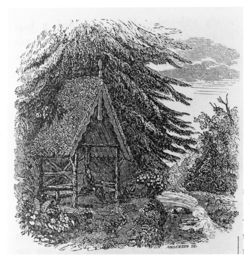
Cascade, cataract, and waterfall were terms used interchangeably to designate a water feature, either natural or artificial, that was part of a designed landscape. These terms, which were synonymous, were in common usage and garden literature by the beginning of the 18th century. Only Noah Webster's dictionary (1828) made any distinction among them, stating that the cataract was a cascade on a large scale. The more frequent synonymous usage of the terms is found in A. J. Downing's essay on Montgomery Place (1847), where he entitled a section, “The cataract,” but then used the term “waterfall” in the text that followed.

This garden feature was achieved either by incorporating a preexisting waterfall into the garden scheme, by enhancing a small falls with the addition of rocks, or by building a completely artificial cascade. Directions for constructing cascades suggest that they were features that could be built on a range of scales, suitable for small gardens, large estates, and public waterways such as Fairmount Waterworks in Philadelphia. J. C. Loudon (1826), in his usual practical way, wrote that the only requirement was a wall to interrupt the flow of a stream or rivulet, causing the water to fall noisily over rocks and uneven surfaces.
The literature often describes waterfalls as part of the view beyond the garden proper. Visitors to Gray’s Garden in Philadelphia in the late 18th century, for example, recalled moving from the garden into the wilderness, where the falls of the Schuylkill were enjoyed before winding back to the garden [Fig. 1]. Downing offered descriptions of several cataracts that were illustrated by Alexander Jackson Davis, including those found at Montgomery Place [Fig. 2] and Blithewood [Fig. 3]. Located in the Hudson River Valley, these cataracts were connected to the designed landscape by the addition of paths, summerhouses, rustic furniture, and bridges. Although it often preexisted the garden, the cascade played a role in the experience of surprise and variety belonging to both the designed and naturally picturesque landscape [Fig. 4]. The feature also could serve as a compositional terminus, as noted by the writer Constantia [Judith Sargent Murray] (1791).
Visitors often described the cascade as one of the most important elements in the sensory experience of the garden since it combined sound, which broke the silence, with the movement and vitality caused by the action of the falling water and its cooling spray. Downing, for example, noted that “[t]his valley is musical with the sound of waterfalls.” The sounds of crashing and gurgling water frequently preceded the view of the cascade, adding suspense to the catalogue of sensations felt by the visitor as he or she walked through the garden.
The question of taste was an issue as well; George William Johnson (1847) noted that a cascade was agreeable “only when properly associated with the scenery around.” The cascade or waterfall in the garden was an important element of the landscape because of the numerous associations it evoked. The cascade at Tivoli, the fountains of Versailles, Virginia Waters at Windsor, were all icons of European garden design that many designers sought to emulate. Others knew cascades such as Great Falls, Virginia, and Niagara Falls, New York, as America’s natural wonders, and writers such as Thomas Jefferson used these sites as proof of the bounty and sublimity of the new nation.
—Therese O’Malley
Texts
Usage
- Anonymous, 1752, South Carolina Gazette (quoted in Lounsbury 1994: 62)[1]
- “To Gentlemen. . . as have a taste in pleasure. . . gardens. . . may depend on having them laid out, leveled, and drained in the most compleat manner, and politest taste, by the subscriber; who perfectly understands. . . erecting water works. . . fountains, cascades, grottos.”
- Jefferson, Thomas, 1771, describing Monticello, plantation of Thomas Jefferson, Charlottesville, VA (1944: 26)[2]
- “. . . a few feet below the spring level the ground 40 or 50 f. sq. let the water fall from the spring in the upper level over a terrace in the form of a cascade. then conduct it along the foot of the terrace to the Western side of the level, where it may fall into a cistern under a temple, from which it may go off by the western border till it falls over another terrace at the Northern or lower side. let the temple be raised 2. f. for the first floor of stone. under this is the cistern, which may be a bath or anything else. the 1st story arches on three sides; the back or western side being close because the hill there comes down, and also to carry up stairs on the outside. the 2d story to have a door on one side, a spacious window in each of the other sides, the rooms each 8. f. cube; with a small table and a couple of chairs. the roof may be Chinese, Grecian, or in the taste of the Lantern of Demosthenes at Athens.”
- Jefferson, Thomas, April 1786, describing Hagley, property of Lord Wescot, England (1944: 113)[2]
- “Hagley, now Lord Wescot’s.—One thousand acres: no distinction between park and garden—both blended, but more of the character of garden. . . This garden occupying a descending hollow between the Clent and Witchbury hills, with the spurs from those hills, there is no level in it for a spacious water. There are, therefore, only some small ponds. From one of these there is a fine cascade; but it can only be occasionally, by opening the sluice. This is in a small, dark, deep hollow, with recesses of stone in the banks on every side. In one of these is a Venus predique, turned half round as if inviting you with her into the recess. There is another cascade seen from the portico on the bridge.”
- Cutler, Manasseh, July 14, 1787, describing Gray’s Tavern, Philadelphia, PA (1987: 1:276–77)[3]
- “When we came to the fence, we were delightfully astonished with the view of one of the finest cascades in America, which presented itself directly before us at the further end of the opening. A broad sheet of water comes over a large horizontal rock, and falls about seventy feet perpendicular. It is in a large river, which empties into the Schuylkill just above us. The distance we judged to be about a quarter of a mile, which being seen through the narrow opening in the tall grove, and the fine mist that rose incessantly from the rocks below, had a most delightful effect. Here we gazed with admiration and pleasure for some time, and then took a different route in our return through the grove, and followed a walk that led down toward the Schuylkill.”
- Constantia [Judith Sargent Murray], June 24, 1790, “Description of Gray’s Gardens, Pennsylvania” (Massachusetts Magazine 3: 415)[4]
- “Suddenly, however, an open plain is outspread before us, and we are presented with a pleasing horizon—but as suddenly, thick trees again intervene, until at the extremity of the walks, a mill and a beautiful natural cascade terminates the prospect.”
- L’Enfant, Pierre-Charles, June 22, 1791, in a report to George Washington, describing his plans for Washington, DC (quoted in Caemmerer 1950: 153)[5]
- “I propose in this map, of leting the [Ti]ber return in its proper channel by a fall which issuing from under the base of the Congress building may there form a cascade of forty feet heigh or more than one hundred waide which would produce the most happy effect in rolling down to fill up the canall and discharge itself in the Potowmack of which it would then appear as the main spring when seen through that grand and majestic avenue intersecting with the prospect from the palace at a point which being seen from both I have designated as the proper for to erect a grand Equestrian figure.”
- Jefferson, Thomas, 1804, describing Monticello, plantation of Thomas Jefferson, Charlottesville, VA (quoted in Nichols and Griswold 1978: 111)[6]
- “The spring of Montalto [Carter’s Mountain] either to be brought to Monticello by pipes or to fall over steps of stairs in cascade, made visible at Monticello through a vista.”
- Anonymous, 1826, describing the Friends Asylum for the Insane, near Frankford, PA (Hawkins 1991: 79)[7]
- “A shaded, serpentine walk, now skirting the edge of the wood, now plunging into its dark and dependent foliage, and embracing, in its windings, more than a mile, leads over a neat and lightly constructed bridge, to a pleasure house, which might justly termed the Temple of Solitude. It is securely founded on a rock, which juts abruptly forth from the declivity of a steep hill, three sides of which are almost perpendicular, and of considerable height. A chasm, formed by nature, in the rock, to the left of the entrance, affords, with the assistance of stones transversely arranged, a descent to the small valley beneath. The straight and towering tulip tree, the sturdy oak, the chestnut, and the beech, cast their cool shadows around this wood-embosomed abode of contemplation. A rapid stream ripples over the rocks, at a few yards distance, producing the melancholy, but pleasing sounds of a distant waterfall.”
- Trollope, Frances Milton, 1830, describing Fairmount Waterworks, Philadelphia, PA, Domestic Manners of the Americans (1832: 2:42–43)[8]
- “The water-works of Philadelphia have not yet perhaps as wide extended fame as those of Marley [at Versailles], but they are not less deserving it. . . It is, in truth, one of the very prettiest spots the eye can look upon. A broad wear is thrown across the Schuylkill, which produces the sound and look of a cascade.” [Fig. 5]
- Thacher, James, November 26, 1830, “An Excursion on the Hudson,” describing the garden of Col. Thaddeus Kosciusko, West Point, NY (New England Farmer 9: 148)[9]
- “Among the interesting recollections pertaining to West Point is Kosciusko’s garden, situated in a deep rocky valley near the river, where in 1778, I was amused in viewing his curious water fountain, spouting jets and cascades. ‘Clusters of lilacs are still growing which are said to have been planted by the Polish Patriot.’”
- Thacher, James, December 3, 1830, “An Excursion on the Hudson,” describing Hyde Park, seat of David Hosack, on the Hudson River, NY (New England Farmer 9: 156)[10]
- “This avenue to the mansion is over a stone bridge, crossing a rapid stream precipitated from the milldams above, and falls in a cascade below. The winding of the road, the varied surface of the ground, the bridge, and the falling of the water, continually vary the prospect and render it a never tiring scene.”
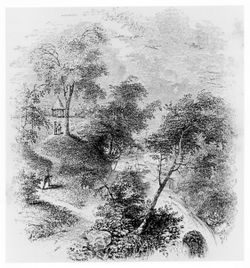
- Donaldson, Robert, December 16, 1840, in a letter to Mrs. Edward (Louise) Livingston, describing the joint border of Montgomery Place, country home of Mrs. Edward (Louise) Livingston, and Blithewood, seat of Robert Donaldson, Dutchess County, NY (quoted in Haley 1988: 76)[11]
- “If we buy the stream. . . our pleasure grounds extend to the creek from the Cataract to the River—& a lake for fish formed, with ornamental waterfalls—which would render the places all that could be desired.” [Fig. 6]
- Downing, Andrew Jackson, October 1847, describing Montgomery Place, country home of Mrs. Edward (Louise) Livingston, Dutchess County, NY (quoted in Haley 1988: 49, 52)[11]
- “He takes another path, passes by an airy looking rustic bridge, and plunging for a moment into the thicket, emerges again in full view of the first cataract. Coming from the solemn depths of the woods, he is astonished at the noise and volume of the stream, which here rushes in wild foam and confusion over the rocky fall, forty feet in depth. Ascending a flight of steps made in the precipitous banks of the stream, we have another view, which is scarcely less spirited and picturesque.
- “This waterfall, beautiful at all seasons, would alone be considered a sufficient attraction to give notoriety to a rural locality in most country neighborhoods. But as if nature had intended to lavish her gifts here, she has, in the course of this valley, given two other cataracts. These are all striking enough to be worthy of the pencil of the artist, and they make this valley a feast of wonders to the lovers of the picturesque. . .
- “On its [the lake] northern bank is a rude sofa, formed entirely of stone. Here you linger again, to wonder afresh at the novelty and beauty of the second cascade. The stream here emerges from a dark thicket, falls about twenty feet, and then rushes away on the side of the peninsula opposite the lake.”
- Downing, Andrew Jackson, October 1847, “A Visit to Montgomery Place,” describing Montgomery Place, country home of Mrs. Edward (Louise) Livingston, Duchess County, NY (Horticulturist 2: 157)[12]
- “THE CATARACT.
- “But the stranger who enters the depths of this dusky wood by this route, is not long inclined to remain here. His imagination is excited by the not very distant sound of waterfalls.
- “‘Above, below, aerial murmurs swell,
- “From hanging wood, brown heath and bushy dell;
- “A thousand gushing rells that shun the light,
- “Stealing like music on the ear of night.’ . . .”
- Downing, Andrew Jackson, 1849, describing Montgomery Place, country home of Mrs. Edward (Louise) Livingston, Dutchess County, NY (1991: 48)[13]
- “This valley is musical with the sound of waterfalls, of which there are several fine ones in the bold impetuous stream which finds its course through the lower part of the wilderness.”
- Justicia [pseud.], March 1849, “A Visit to Springbrook,” seat of Caleb Cope, near Philadelphia, PA (Horticulturist 3: 411)[14]
- “To the left of this grove is a sheet of spring water, rising on the farm, (which farm contains upwards of 100 acres,) that supplies a powerful Hydraulic Ram, diffusing the water over the whole place, supplying reservoirs, fountains, waterfalls, &c.”
- Twain, Mark, October 26, 1853, describing Fairmount Waterworks, Philadelphia, PA (quoted in Gibson 1988: 2)[15]
- “We arrived at Fairmount. . . Here I saw, a little above, the fine dam, which holds back the water for the use of the Water Works. It forms quite a nice water-fall.”
- Watson, John Fanning, 1857, describing Fairmount Waterworks, Philadelphia, PA (1:489)[16]
- “There we see the graceful, glittering river winding amongst its wooded banks, the artificial cascade at your feet, the lovely jet d’eaux all around, the green plats and gravelled walks through which you have walked, the picturesque views wherever you cast your eyes, these go to make up the picture which is spread out in rich luxuriance before you.”
Citations
- Chambers, Ephraim, 1741, Cyclopaedia (1741: 1:n.p.)[17]
- “CASCADE,*a steep fall of water, from a higher into a lower place. See CATARACT.
- “*The word is French, formed of the Italian cascata, which signifies the same; of cascare to fall; and that from the latin cadere.
- “Cascades are either natural, as that of Tivoli; or artificial, as those of Versailles, &c. and either falling with a gentle descent, as those of the Sceaux; in form of a buffet, as at Trianon; or down steps, in form of a perron, as at St. Clou; or from bason to bason, &c. . .
- “CATARACT *of Water, a fall, or precipice, in the channel, or bed of a river; caused by rocks, or other obstacles, stopping the course of its stream: from whence the water falls with a great noise and impetuosity.
- “*The word comes from the Greek. . . cum impetu decido, I tumble down with violence; compounded of. . . down; and. . . dejicio, I throw down.”
- Sheridan, Thomas, 1789, A Complete Dictionary of the English Language (1789: n.p.)[18]
- “CASCADE, kas-ka’de. s. A cataract, a waterfall. . .
- “CATARACT, kat’-a-rakt. s. A fall of water from on high, a cascade.”
- M’Mahon, Bernard, 1806, The American Gardener’s Calendar (1806: 61)[19]
- “Cascades, and other water-falls, have also a fine effect, where there is a constant plentiful stream, and the situation proper to give the water a due fall, from a higher to a lower part, upon a parcel of rugged stones, to increase the noise, and break and disperse the water.”
- Loudon, J. C. (John Claudius), 1826, An Encyclopaedia of Gardening (1826: 358, 1012)[20]
- “1822. Of constructions for displaying water, as an artificial decoration, the principal are cascades, waterfalls, jets, and fountains. . .
- “1826. The construction of the waterfall, where avowedly artificial, is nothing more than a strong-built wall across the stream, perfectly level at top, and with a strong, smooth, accurately fitted, and well jointed coping. . . Where a natural waterfall is to be imitated, the upright wall must be built of huge irregular blocks; the horizontal lamina of water broken in the same way by placing fragments of rocks grouped here and there so as to throw the whole into parts; and as nature is never methodical, to form it as if in part a cascade. . .
- “1827. In imitating a natural cascade in garden-scenery, the horizontal line must here also be perfect, to prevent waste of water in dry seasons, and from this to the base of the lower slope the surface must be paved by irregular blocks, observing to group the prominent fragments, and not distribute them regularly over the surface. . .
- “1828. The greatest danger in imitating cascades and waterfalls, consisting in attempting too much, a very few blocks, disposed with a painter’s eye, will effect all that can be in good taste in most garden-scenes; and in forming or improving them in natural rivers, there will generally be found indications both as to situation and style, especially if the country be uneven, or stony, or rocky. . .
- "7216. Water is a material of so captivating and interesting a description in the different characters in which it does not compose a feature. It forms a part of every garden in the ancient style in the various artificial characters which it there assumes of oblong canals, ponds, basins, cascades, and jeux-d’eau (fig. 694) ;"

- “7225. A waterfall, or cascade, is an obvious improvement where a running stream passes through a demesne . . .and is to be formed by first constructing a bank of masonry, presenting an inclined plane (a) to the currents, and rendering it impervious to water by puddling (1720.) or the use of proper cements, and next varying the ridge (b) and under side (c), with fragments of rock, so chosen and placed, as not to present a character foreign to what nature may be supposed to have produced there. The adjoining ground generally requires to be raised at such scenes, but may generally be harmonised by plantation. [Fig. 7]
- “7226. Where running water is conducted in forms belonging to the geometric style of gardening, waterfalls and cascades are constructed in the form of crescents, flights of steps, or wavy slopes.”
- Webster, Noah, 1828, An American Dictionary of the English Language (1828: 1:n.p.)[21]
- “CASCA'DE, n. [Fr. cascade; Sp. cascada; It. cascata, from cascare, to fall.]
- “A waterfall; a steep fall or flowing of water over a precipice, in a river or natural stream; or an artificial fall in a garden. The word is applied to falls that are less than a cataract. . .
- “CAT'ARACT, n. [L. cataracta; . . . ]
- “1. A great fall of water over a precipice; as that of Niagara, of the Rhine, Danube and Nile. It is a cascade up on a great scale.
- “The tremendous cataracts of America thundering in their solitudes. Irving. . .
- “WATERFALL, n. [water and fall.] A fall or perpendicular descent of the water of a river or stream, or a descent nearly perpendicular; a cascade; a cataract. But the word is generally used of the fall of a small river or rivulet. It is particularly used to express a cascade in a garden, or an artificial descent of water, designed as an ornament. Cyc .”
- Anonymous, April 1, 1837, “Landscape Gardening” (Horticultural Register 3: 130)[22]
- “Trees and shrubs in front of the house should be planted and pruned so as to present a chaste and neat appearance; imitations, therefore, of the wilder scenes of nature, such as rocks, cascades, old trees, and festoons of climbing plants, should be situated back and more remote.”
- Johnson, George William, 1847, A Dictionary of Modern Gardening (1847: 132–33, 233–34)[23]
- “CASCADE, or Waterfall, is an important adjunct in landscape gardening, but agreeable only when properly associated with the scenery around; that association is a bold broken ground, and a dense plantation of trees; nothing is more misplaced or tasteless than a sheet of water falling into another uniform collection of water, in an open unwooded plain. Mr. Whateley justly observes, that ‘a rill cannot pretend to any sound beyond that of a little waterfall; the roar of a cascade belongs only to larger streams: but it may be introduced by a rivulet to a considerable degree, and attempts to do more have generally been unsuccessful; a vain ambition to imitate nature in her great extravagancies betrays the weakness of art. Though a noble river throwing itself headlong down a precipice be an object truly magnificent, it must however be confessed, that in a single sheet of water there is a formality which its vastness alone can cure, but the height, not the breadth is the wonder: when it falls no more than a few feet, the regularity prevails, and its extent only serves to expose the vanity of affecting the style of a cataract in an artificial cascade; it is less exceptionable if divided into several parts, for then each separate part may be wide enough for its depth; and in the whole, variety, not greatness, will be the predominant character. But a structure of rough, large, detached stones cannot easily be contrived of strength sufficient to support a great weight of water, it is sometimes from necessity almost smooth and uniform, and then it loses much of its effect: several little falls in succession are preferable to one greater cascade, which in figure, or in motion, approaches to regularity.
- “‘When greatness is thus reduced to number, and length becomes of more importance than breadth, a rivulet vies with a river, and it more frequently runs in a continued declivity, which is very favourable to such a succession of falls. Half the expense and labour which are sometime bestowed on a river to give it at the best, a forced precipitancy in any one spot only, would animate a rivulet through the whole of its course; and after all the most interesting circumstance in falling waters, is their animation: a great cascade fills us with surprise, but all surprise must cease; and the motion, the agitation, the rage, the froth, and the variety of the water are finally the objects which engage the attention; for these a rivulet is sufficient, and they may there be produced without that appearance of effort which raises a suspicion of art. To obviate such a suspicion, it may sometimes be expedient to begin the descent out of sight; for the beginning is the difficulty: if that be concealed, the subsequent falls seem but a consequence of the agitation which characterizes the water at its first appearance, and the imagination is, at the same time, let loose to give ideal extent to the cascades; when a stream issues from a wood, such management will have a great effect, the bends of its course in an open exposure may afford frequent opportunities for it, and sometimes a low broad bridge may furnish the occasion, a little fall hid under the arch will create a disorder, in consequence of which, a greater cascade below will appear very natural. . .
- “FOUNTAINS. . .
- “Drooping fountains, or such as bubbling from their source trickle over the edge of rocks, shells, or vases, combining the cascade with the fountain, are capable of much greater beauty.”
- Downing, Andrew Jackson, 1849, A Treatise on the Theory and Practice of Landscape Gardening (1849; repr., 1991: 364)[24]
- “Cascades and water-falls are the most charming features of natural brooks and rivulets. Whatever may be their size they are always greatly admired, and in no way is the peculiar stillness of the air, peculiar to the country, more pleasingly broken, than by the melody of falling water. . . Now any one who examines a small cascade at all attentively, in a natural brook, will see that it is often formed in the simplest manner by the interposition of a few large projecting stones, which partially dam up the current and prevent the ready flow of the water. Such little cascades are easily imitated.”
Images
Inscribed
Batty Langley, “The Design of a Fountain & Cascade after the grand Manner at Versailes,” in New Principles of Gardening (1728), pl. XVII.
Pierre-Charles L'Enfant, “Plan of the City intended for the Permanent Seat of the Government of the United States. . . ,” 1791. The cascade is labelled "F".
Cornelius Tiebout, “View of the Falls of Schuylkill, five miles from Philadelphia,” 1793.
J. C. Loudon, “A waterfall, or cascade,” in An Encyclopaedia of Gardening (1826), 1012, fig. 700.
Anonymous, “Rustic Seat,” Montgomery Place, in A. J. Downing, ed., Horticulturist 2, no. 4 (October 1847): 157, fig. 26.
Anonymous, “The Cataract at Blithewood,” in A. J. Downing, A Treatise on the Theory and Practice of Landscape Gardening (1849), opp. 364, fig. 41.
Associated
J. C. Loudon, A garden in the ancient style, in An Encyclopaedia of Gardening (1826), 1009, fig. 694.
Alexander Jackson Davis, View in Grounds at Blithewood, Seat of Robt. Donaldson, Dutchess Co. Hud.[son] riv[er]. N.Y., 1840.
Alexander Jackson Davis, “View in the Grounds at Blithewood,” in A. J. Downing, A Treatise on the Theory and Practice of Landscape Gardening (1849), frontispiece.
Anonymous, Initial, Treatment of Water, in A. J. Downing, A Treatise on the Theory and Practice of Landscape Gardening (1849): 347.
Alexander Jackson Davis, “Bank-Side Walk,” Blithewood, 1849.
Alexander Jackson Davis, Three figures going up a hill to a gazebo at Blithewood, n.d. (c. 1849).
Attributed
Robert Campbell, after Thomas Birch, View of the Dam and Water Works at Fairmount, Philadelphia, 1824.
Notes
- ↑ Carl R. Lounsbury, ed., An Illustrated Glossary of Early Southern Architecture and Landscape (New York: Oxford University Press, 1994), view on Zotero.
- ↑ 2.0 2.1 Thomas Jefferson, The Garden Book, ed. Edwin M. Betts (Philadelphia: American Philosophical Society, 1944), view on Zotero.
- ↑ William Parker Cutler, Life, Journals, and Correspondence of Rev. Manasseh Cutler, LL.D. (Athens: Ohio University Press, 1987), view on Zotero.
- ↑ Constantia [Judith Sargent Murray], “Description of Gray’s Gardens, Pennsylvania,” Massachusetts Magazine, or, Monthly Museum of Knowledge and Rational Entertainment 7, no. 3 (July 1791): 413–17, view on Zotero.
- ↑ H. Paul Caemmerer, The Life of Pierre-Charles L’Enfant, Planner of the City Beautiful, The City of Washington (Washington, DC: National Republic Publishing Company, 1950), view on Zotero.
- ↑ Frederick Doveton Nichols and Ralph E. Griswold, Thomas Jefferson, Landscape Architect (Charlottesville: University Press of Virginia, 1978), view on Zotero.
- ↑ Kenneth Hawkins, “The Therapeutic Landscape: Nature, Architecture, and Mind in Nineteenth-Century America” (PhD diss., University of Rochester, 1991), view on Zotero.
- ↑ Frances Milton Trollope, Domestic Manners of the Americans, 2nd ed., 2 vols. (London: Wittaker, Treacher & Co., 1832), view on Zotero.
- ↑ James Thacher, “An Excursion on the Hudson. Letter II,” New England Farmer, and Horticultural Journal 9, no. 19 (November 26, 1830): 148–49, view on Zotero.
- ↑ James Thacher, “An Excursion on the Hudson. Letter II,” New England Farmer, and Horticultural Journal 9, no. 20 (December 3, 1830): 156–57, view on Zotero.
- ↑ 11.0 11.1 Jacquetta M. Haley, ed., Pleasure Grounds: Andrew Jackson Downing and Montgomery Place (Tarrytown, NY: Sleepy Hollow Press, 1988), view on Zotero.
- ↑ Alexander Jackson Downing, ed., “A Visit to Montgomery Place,” Horticulturist and Journal of Rural Art and Rural Taste 2, no. 4 (October 1847): 153–60, view on Zotero.
- ↑ A. J. [Andrew Jackson] Downing, A Treatise on the Theory and Practice of Landscape Gardening, Adapted to North America, 4th ed. (1849; repr., Washington, DC: Dumbarton Oaks Research Library and Collection, 1991), view on Zotero.
- ↑ Justicia [pseud.], “A Visit to Springbrook, the Seat of the President of the Pennsylvania Horticultural Society,” Horticulturist and Journal of Rural Art and Rural Taste 3, no. 9 (March 1849): 411–14, view on Zotero.
- ↑ Jane Mork Gibson, “The Fairmount Waterworks,” Bulletin, Philadelphia Museum of Art 84 (1988): 5–40, view on Zotero.
- ↑ John Fanning Watson, Annals of Philadelphia and Pennsylvania in the Olden Time; Being a Collection of Memoirs, Anecdotes, and Incidents of the City and Its Inhabitants, and of the Earliest Settlements of the Inland Part of Pennsylvania, from the Days of the Founders, 2 vols. (Philadelphia: E. Thomas, 1857), view on Zotero.
- ↑ Ephraim Chambers, Cyclopaedia, or An Universal Dictionary of Arts and Sciences. . . , 5th ed., 2 vols. (London: D. Midwinter et al., 1741–43), view on Zotero.
- ↑ Thomas A. Sheridan, A Complete Dictionary of the English Language, Carefully Revised and Corrected by John Andrews. . . , 5th ed. (Philadelphia: William Young, 1789), view on Zotero.
- ↑ Bernard M’Mahon, The American Gardener’s Calendar: Adapted to the Climates and Seasons of the United States. Containing a Complete Account of All the Work Necessary to Be Done . . . for Every Month of the Year. . . (Philadelphia: Printed by B. Graves for the author, 1806), view on Zotero.
- ↑ J. C. (John Claudius) Loudon, An Encyclopaedia of Gardening; Comprising the Theory and Practice of Horticulture, Floriculture, Arboriculture, and Landscape-Gardening, 4th ed. (London: Longman et al., 1826), view on Zotero.
- ↑ Noah Webster, An American Dictionary of the English Language, 2 vols. (New York: S. Converse, 1828), view on Zotero.
- ↑ Anonymous, “Landscape Gardening,” Horticultural Register, and Gardener’s Magazine 3 (April 1, 1837): 121–31, view on Zotero.
- ↑ George William Johnson, A Dictionary of Modern Gardening, ed. David Landreth (Philadelphia: Lea and Blanchard, 1847), view on Zotero.
- ↑ A. J. [Andrew Jackson] Downing, A Treatise on the Theory and Practice of Landscape Gardening, Adapted to North America, 4th ed. (1849; repr., Washington, DC: Dumbarton Oaks Research Library and Collection, 1991), view on Zotero.

